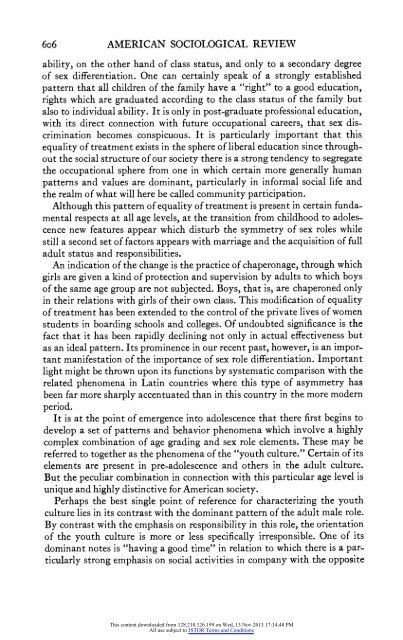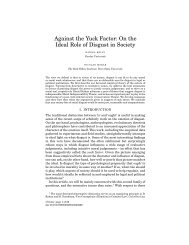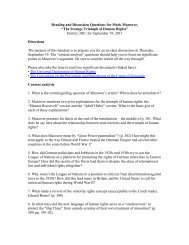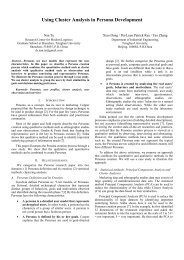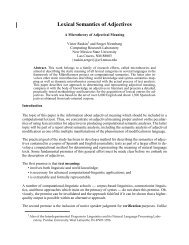Parsons 1942 - Career Account Web Pages
Parsons 1942 - Career Account Web Pages
Parsons 1942 - Career Account Web Pages
Create successful ePaper yourself
Turn your PDF publications into a flip-book with our unique Google optimized e-Paper software.
6o6<br />
AMERICAN SOCIOLOGICAL REVIEW<br />
ability, on the other hand of class status, and only to a secondary degree<br />
of sex differentiation. One can certainly speak of a strongly established<br />
pattern that all children of the family have a "right" to a good education,<br />
rights which are graduated according to the class status of the family but<br />
also to individual ability. It is only in post-graduate professional education,<br />
with its direct connection with future occupational careers, that sex discrimination<br />
becomes conspicuous. It is particularly important that this<br />
equality of treatment exists in the sphere of liberal education since throughout<br />
the social structure of our society there is a strong tendency to segregate<br />
the occupational sphere from one in which certain more generally human<br />
patterns and values are dominant, particularly in informal social life and<br />
the realm of what will here be called community participation.<br />
Although this pattern of equality of treatment is present in certain fundamental<br />
respects at all age levels, at the transition from childhood to adolescence<br />
new features appear which disturb the symmetry of sex roles while<br />
still a second set of factors appears with marriage and the acquisition of full<br />
adult status and responsibilities.<br />
An indication of the change is the practice of chaperonage, through which<br />
girls are given a kind of protection and supervision by adults to which boys<br />
of the same age group are not subjected. Boys, that is, are chaperoned only<br />
in their relations with girls of their own class. This modification of equality<br />
of treatment has been extended to the control of the private lives of women<br />
students in boarding schools and colleges. Of undoubted significance is the<br />
fact that it has been rapidly declining not only in actual effectiveness but<br />
as an ideal pattern. Its prominence in our recent past, however, is an important<br />
manifestation of the importance of sex role differentiation. Important<br />
light might be thrown upon its functions by systematic comparison with the<br />
related phenomena in Latin countries where this type of asymmetry has<br />
been far more sharply accentuated than in this country in the more modern<br />
period.<br />
It is at the point of emergence into adolescence that there first begins to<br />
develop a set of patterns and behavior phenomena which involve a highly<br />
complex combination of age grading and sex role elements. These may be<br />
referred to together as the phenomena of the "youth culture." Certain of its<br />
elements are present in pre-adolescence and others in the adult culture.<br />
But the peculiar combination in connection with this particular age level is<br />
unique and highly distinctive for American society.<br />
Perhaps the best single point of reference for characterizing the youth<br />
culture lies in its contrast with the dominant pattern of the adult male role.<br />
By contrast with the emphasis on responsibility in this role, the orientation<br />
of the youth culture is more or less specifically irresponsible. One of its<br />
dominant notes is "having a good time" in relation to which there is a particularly<br />
strong emphasis on social activities in company with the opposite<br />
This content downloaded from 128.210.126.199 on Wed, 13 Nov 2013 17:34:48 PM<br />
All use subject to JSTOR Terms and Conditions


